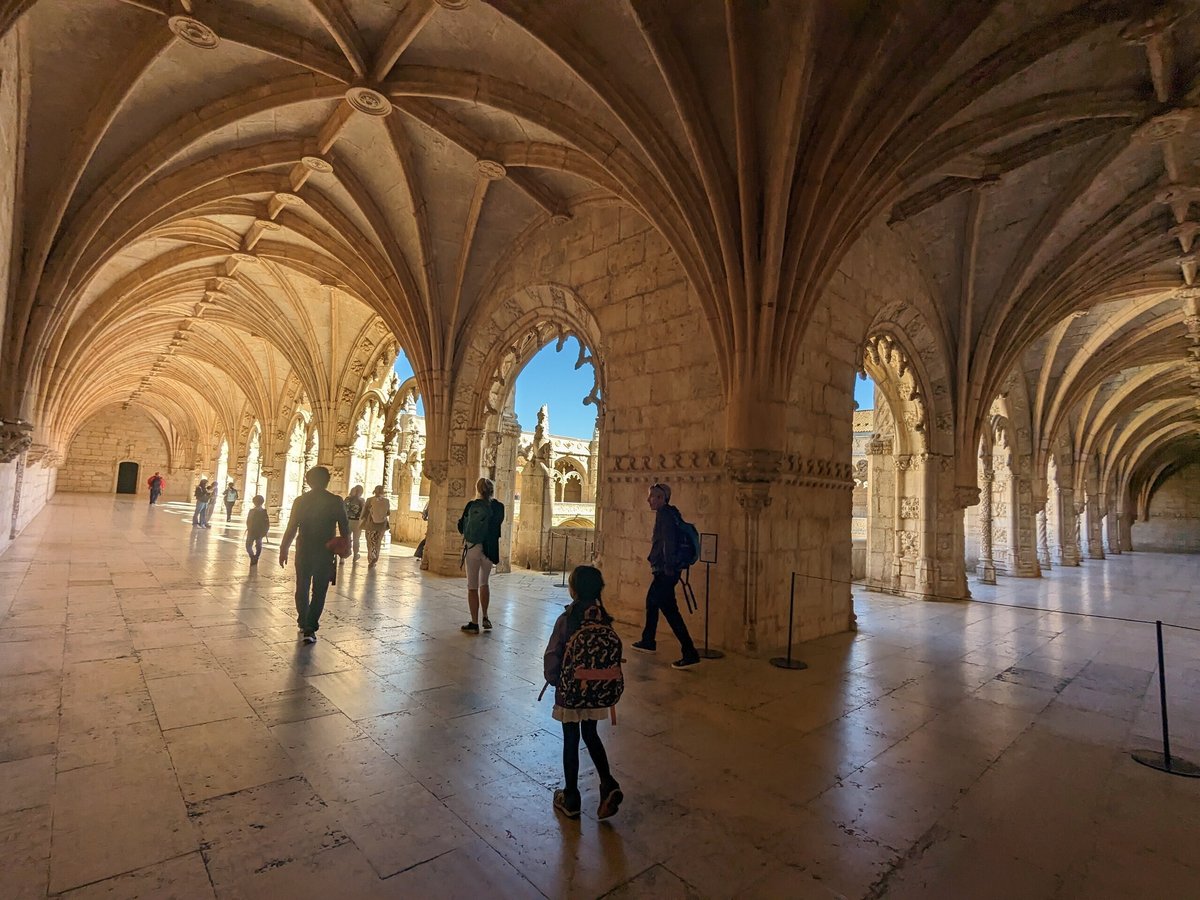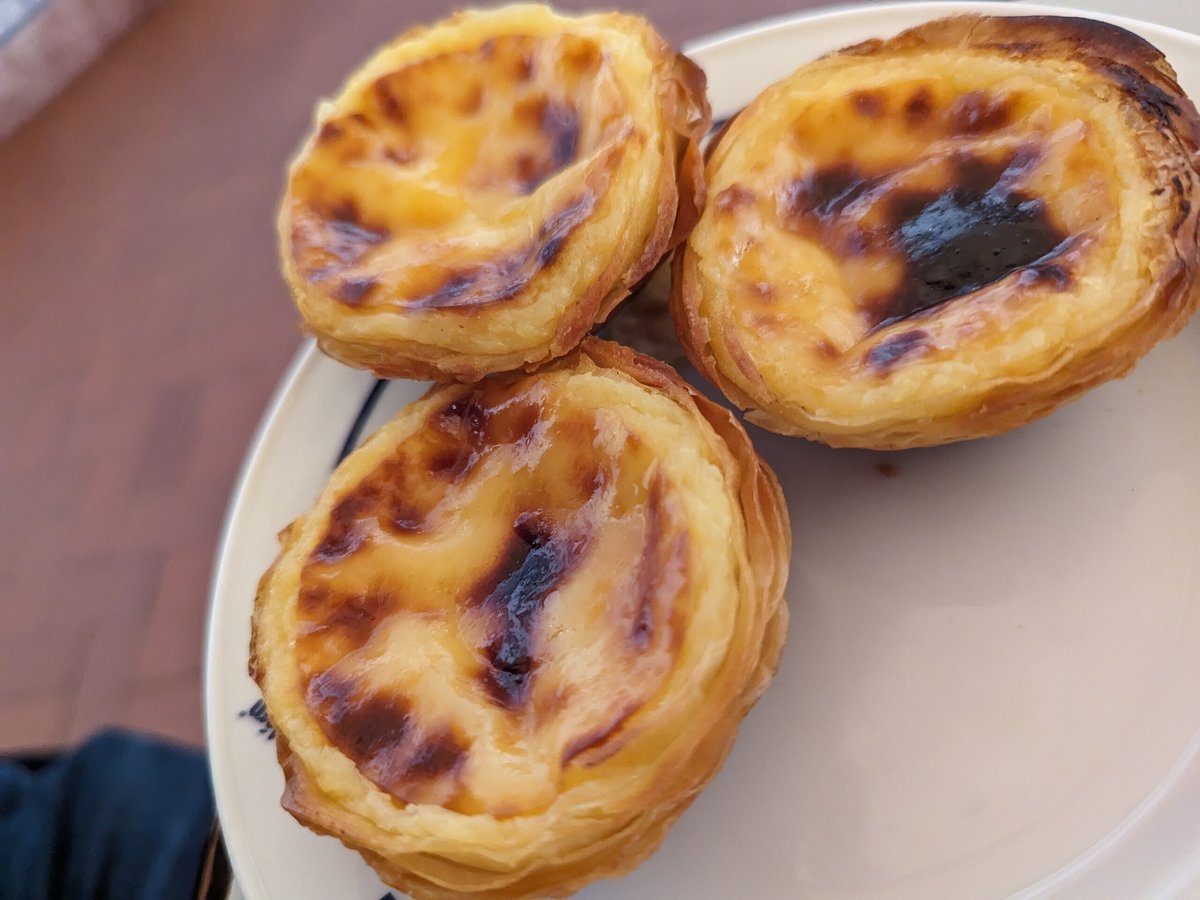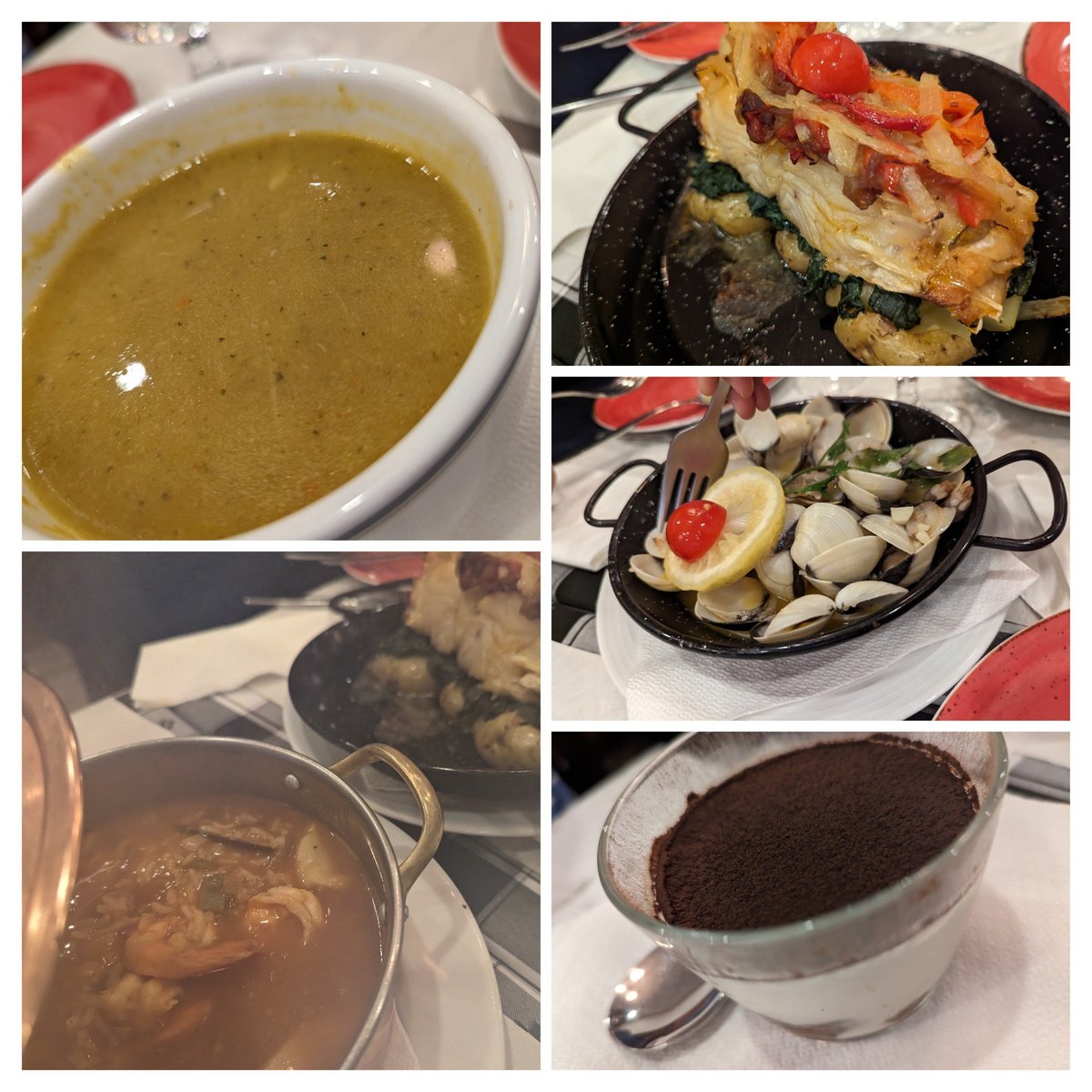
リスボン - Lisboa (3) ベレン地区、冒険者たちの夢の跡
<English Follows>
昔々、希望岬を超えてインド航路を開拓したポルトガルが、欧州で一番イケてる国だった時代がありました。
エンリケ航海王の後押しでインド航路を拓いたバスコ・ダ・ガマが持ち帰った胡椒は、一発で実に70回分のプロジェクト(当時の航海)を賄う利益をもたらしたそうです。前日に訪れた水族館の近くのショッピングモールも「バスコ・ダ・ガマ」、国民的ヒーローですね。
さて、そんな栄光の日々の航海で得た巨万の富をもって建てられたのが、リスボン随一の観光名所、ジェロニモス修道院です。開館ちょうどくらいに到着したら既に大行列で、事前予約してたのに約1時間並びました。天気がいいからまあ我慢できたけど、夏は辛いだろうなあ。

しかし中に入るとゆったりと見て回れました。古い天井画の色合わせがかわいい。

内装のタイルも美しい。

けど、この修道院の見どころは、なんといっても白い石造りの回廊。石造りのアーチの天井も、細かい彫刻を施した支柱も、ため息の出る美しさ。

どの角度から見てもいい。ロンドンとは空の青が違う。ネジネジした装飾が多い。柱の一つ一つ、デザインが違うのです。

人混みに邪魔されず、好きなだけ静かに見て回れたので、そればかりは入場制限に感謝だね。

実は隣の教会も同じチケットで入れたはずなんだけど、一旦外に出てまた別の行列に1時間並べというので諦めました。イースター休暇だから仕方ない。
ジェロニモス修道院はリスボン名物・エッグタルトの発祥地でもあります。ここという有名店がすぐそばにあって、わたしたちもその、門外不出のレシピで作ったというタルトを食べに行きました。
テイクアウトに長い行列ができていましたが、奥には巨大なカフェ・エリアがあって、イートインはすぐに案内されました。サンドイッチなどのランチメニューもいろいろあります。壁のタイルがかわいかった。

タルトはこちら、皮のパリっとしたかんじと、クリームのトロっとした感じがおいしかったです。ロンドンでもスーパーで似たようなのが売ってるんだけど、わたしはタルト好きではないので買ったことがない。がっかりするかもだけど、一度くらいロンドンでも試してみようかな。

食後は、ジェロニモス修道院の隣りの海洋博物館に行きました。
この博物館は、ガラガラなのにめっちゃ充実していて、チョー穴場でした。まず、入り口で迎えてくれるのが大きなエンリケ航海王子の像。

ポルトガルは、その黄金期の富を国内殖産につなげることができず、その後の植民地競争で他の欧州諸国に押し負け衰退したのですが、彼は間違いなく大航海時代の先鞭をつけた偉大な王だったのです。
まあ、勝った国々の悪辣非道とそれの招いた戦争が今も続く世界を見ていると、強いのが良いとも思わない。それよか、誰も地球の全体像を知らない時代にリスクをとって未知の世界に乗り出し、少しづつ世界地図の精度を上げていった冒険者たちの仕事ってわくわくします。

最初はちょびっとだけの情報しかなくてあやふやな海岸線が、航海を重ねる中でどんどんつながり、わたしたちのお馴染みの世界地図に近づいていく様子が興味深かったです。
未完の地図には、「この土地でこんな動物見たよ!」な絵も描かれていて。恐ろしげな獣(ライオン?)とか、極彩色の鳥(コンゴウインコ?)などの絵に、それを生まれて初めてみた人の感動が写し込まれているようでした。
今でこそ、World Wide Web のおかげさまで世界中が可視化され、珍しい生き物を見放題だけど。かつてその根には、好奇心に導かれた先人の冒険があったのです。
当時の冒険者たちが大海原で位置を知るよすがにしたのは天体でした。丁寧に描かれた天球儀は装飾品ではなく、命を預ける実用品だったのね。

最果ての地・日本にかかわる展示もありました。フェルナン・メンデス・ピントという冒険者の「日本人は、他のどの国よりも名誉を重んじる」という言葉と共に、日本地図も展示されていました。
日本人になじみの深いフランシスコ・ザビエルも、本人はスペイン人だけどポルトガル王にスポンサーされて日本に来ました。鎖国時代、ポルトガルによるキリスト教布教を食い止めるために作られたのが長崎の出島。のちに出禁を食らってオランダに取って代わられますが、日本で南蛮貿易といえば、まずはポルトガルとの通商でした。

その辺が個人的に一番興味深かったところですが、子供たちは、帆船の模型や実際に使われていた船の梶や大砲などが面白かったようです。近代の軍艦や潜水艦などの展示、ポルトガル王室の海洋研究用の船の内装展示などもたっぷり続き、最後に、大きな倉庫のようなスペースに、昔の船の実物がいっぱい展示されていました。

一巡りしたあと、売店前のカフェでレモネード飲みました。中庭を挟んで向いに見えているのが博物館の入り口。実はこの博物館、ジェロニモス修道院の一角です。隣はあんな馬鹿みたいに混んでるのにこっちはガラ空き。建築の内装やステンドグラスも楽しめるので、船好きな人はもとより、みんなにおすすめしたい。

それから、「発見のモニュメント」まで歩いて行きました。左右にポルトガルの大航海時代を支えた王族や冒険家、歴史家、航海士、神学者などが刻まれています。

このモニュメント、そんなに並ばずエレベーターで上がれます。6階建で頂上は狭く、大人でも覗き込まないと広場がみえないコンクリートの手すりで囲われています。遠くにベレンの塔とそこに並ぶ人の群れが見えました。並びたくないから見るだけで満足です。

夕ご飯は友達おすすめで予約したレストランに行きました。
ここで特に気に入ったのは野菜のスープ!写真的にはあまり映えない(左上)けど、この旨味は何?野菜だけ?って深い味わいに感動。デザートのティラミスも甘すぎず絶品、いいお店でした。

なお、そんなポルトガルの栄光を見たあとで余計に感じてしまったのは、その後250年の衰退を経た今のポルトガルは、大国とは言えない、慎ましやかな国だということです。
数日歩き回って気がついたけど、街の中、どこもかしこもボロいのね。落書きだらけ。治安が良いはずの街並みも、あっちもこっちも誰かの落書きが放置されている。昔の職人が心を込めて作ったであろう綺麗なタイルやアイロンフェンスが、汚い落書きと共存している。よく見たら石畳もゴロゴロ壊れっぱなしで補修されていないところが目立つ。坂道が多いので、足元見て歩かないとつまづきます。
同じ観光で儲けている街でも、2月に訪れたランサローテ島では自治体が景観維持を徹底していて隅々まで綺麗だったから、余計に、おおらかさと言うより余裕のなさかなって思ってしまいました。

黄金期のあれこれを見た後では、これらがなければ古い街並みももっと美しく、歩いていて気持ちがよかっただろうにと感じられました。
まあ、慎ましくてもこれだけ天気良くて食べ物が美味しかったら、人生楽しいんだろうけどね。
★
Portugal, which pioneered the Indian route beyond the Cape of Good Hope, was the brightest country in Europe around the 15th century. It is said that spices brought back by Vasco da Gama (the first European to reach India by sea), with the backup of "Infante Dom" Henrique, made wealth to support 70 voyages then. I found the shopping mall near the aquarium we visited was also named "Vasco da Gama". He seems to be a historical hero.
The Jerónimos Monastery in Belém district is a UNESCO World Heritage Site and one of Lisbon's best tourist attractions. It was built with the vast wealth obtained from such voyages in the old days.
When we arrived at the opening time, there was already a long line, and we had to wait for about an hour even though we had booked our places online in advance. It was a nice day, but I bet it would be tough in the summertime.
However, once you get inside, I appreciate the controlled entry. Enough spaces allow you to walk around in serenity.
I liked the fading colour of the old ceilings. The tiles on the interior are also beautiful. But the highlight of this monastery is undoubtedly the white stone cloister. The stone-arched pillars are just breathtaking.
I had the time. There are many spiral decorations, and each pillar has a different design. Even the sky's blue is somewhat different from that we see in London.
Our ticket was actually eligible to get into the church next door, but we skipped it because it meant going outside again and waiting in a different line for yet another hour. Yes, it was a day during the Easter holiday.
Then we visited the cafe Pastéis de Belém. Steeped in history and tradition, their celebrated egg tart is known to retain the original recipe of the Jerónimos monks, a closely guarded secret for generations.
Since there was a long line for takeout, we decided to eat in. There was a huge cafe area where we could order various lunch menus, including sandwiches.
The tart had a crispy crust and smooth custard. Amazing. I've seen similar ones at supermarkets in London but have yet to try them, so I can't compare. Should I give them a go? Or should I avoid them to avoid disappointment?
After lunch, we visited the Maritime Museum next to the Jerónimos Monastery. This museum was surprisingly fulfilling and exceeded my expectations. Only a few people were there, and I felt like I'd stumbled upon a hidden gem.
First, you are greeted by a large statue of Prince Henry the Navigator at the entrance. In the long run, Portugal could not connect the wealth of its golden age to domestic industry. It was eventually defeated and declined in the subsequent colonial competition with other European countries. However, Henry was undoubtedly the great prince who pioneered the Age of Discovery.
Looking at the world today, where the wars and miseries caused by the colonial era victors continue, it's not fair to say that strong countries are good countries. Rather, I respect those courageous people who ventured into the unknown world when no one knew the whole picture of the earth and gradually collected information to improve the accuracy of the world map.
The unfinished maps on display captured my imagination. Crude sketches of coastlines based on fragmentary information, adorned with images of fearsome beasts (perhaps lions?) and vibrant birds (possibly macaws), revealed the awe of explorers encountering these wonders for the first time. It was fascinating to see how these tentative lines gradually coalesced into the familiar world map we know today as voyages accumulated.
Today, the World Wide Web and technologies allow us to access marvellous images of places or things effortlessly. However, these modern conveniences stand on the shoulders of those great people who ventured into the unknown, driven by curiosity and a thirst for discovery.
Among the rich exhibits was a map of Japan, with a quote from adventurer Fernão Mendes Pinto: "and these Japanese are much more ambitious of honour than all other nations of the world". Friends, are we still lighting the altar of honour in this modern age?
Well, Portugal has a long history with our country, Japan. The Portuguese King sponsored Francisco Xavier, a well-known Spanish missionary. "DEJIMA" in Nagasaki was built to stop the spread of Christianity during the "SAKOKU" era (a self-imposed isolation period). Later, Portugal was banned from there and replaced by the Dutch, but the term "NANBANJIN" in Japan initially referred to the Portuguese.
While the museum highlighted Portugal's glorious past as a pioneer of maritime exploration, it also acknowledged the nation's subsequent decline over the following 250 years. As I strolled through the museum, I couldn't help but notice the abundance of graffiti throughout the city. This contrast between the grandeur of Portugal's historical legacy and the imperfections of its present state left me with a mixed sense of admiration and melancholy.
I found the exhibits related to history the most interesting, but children seemed more interested in the model ships, the large rudders and cannons used on ships, and so on. There was also a warehouse where many reships from the past were displayed.
After making the rounds, we enjoyed lemonades at a cafe in front of the gift shop. Across the courtyard, we saw the entrance to the museum, which is indeed a corner of the Jerónimos Monastery. I highly recommend this museum to everyone, not just ship enthusiasts, as you can enjoy the architecture and stained glass. It was so empty even though the neighbouring place was crazily packed.
After that, we walked to the Monument of Discoveries near there. The statues of the Portuguese royalty, adventurers, historians, navigators, and theologians who supported the Portuguese Age of Discovery are engraved on either side.
We could take an elevator to the top of this monument without much of a wait. It is a six-story building, and the top is narrow and surrounded by a concrete railing that even adults have to peer over to see the square. The Tower of Belém and the crowd of people lining up there in the distance. I was satisfied with just seeing it, as I didn't want to wait in line.
Our day concluded with a delightful dinner at a highly-rated seafood restaurant, O castico, recommended by a friend. The flavours were exquisite, a testament to the restaurant's reputation as a long-standing establishment.
Overall, Jerónimos Monastery and the Maritime Museum provided a fascinating glimpse into Portugal's rich history and its complex relationship with Japan. While the country may not be considered wealthy by today's standards, its vibrant culture, stunning scenery, and delicious cuisine make it truly a place to visit.
この記事が気に入ったらサポートをしてみませんか?
